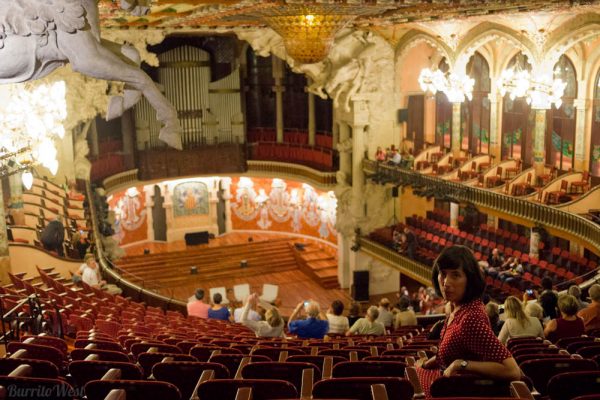London Fringe: Front and Center
Izzi Duprey discovered a brand new genre of theatre while abroad in London. Now, fringe is one of her favorite types. (Photo courtesy of Lisa via Flickr)
July 4, 2017
Living in New York City, I head to the notable theatre box offices dotting Midtown Manhattan whenever I can, hoping to score affordable tickets. Sometimes, it’s easy. I can wake up at a reasonable hour on a Saturday and walk to the Imperial Theater on West 45th Street to pick up an orchestra ticket to “Natasha, Pierre & The Great Comet of 1812.” Other times, it’s not so simple. To get standing room tickets to see Tony-winner Ben Platt in “Dear Evan Hansen,” my friends and I split the midnight to 10 a.m. wait into shifts; in my case, that meant getting up before the sun to stand on the sidewalk at 5 a.m. (If you’re wondering, it was worth it.) For shows like “Hamilton,” I gave in and bought a ticket online six months in advance.
Upon deciding to come to London this summer, I was excited to continue my musical theatre streak—now on the West End. My first weekend here, I sat second row at “42nd Street” and was blown away. Already making plans with my friends to see “Les Miserables,” and sure that I would see my all-time favorite show, “Wicked,” at some point during my stay, I was beyond excited. By week two, our class had stood onstage at the Savoy Theatre after seeing “Dreamgirls.” I had even, by chance, been handed a free ticket to see “The Play That Goes Wrong” as I headed into the box office to buy a last-minute ticket. I was convinced that my life as a theatergoer could not get any better. Then, it did.
Our class took a trip to Richmond, on the outskirts of London, to the Orange Tree Theatre to see a show I hadn’t heard of before. I watched Branden Jacobs-Jenkins’ “An Octoroon” in awe—I had never seen anything like it or even known anything like it existed. “An Octoroon” piqued my interest in what I quickly learned is London’s Fringe theatre.
While many people are familiar with the concept of a show being “off-Broadway” or even “off-West End,” British Fringe is different. Fringe gives shows the chance to start at small venues and gain recognition and appreciation without massive budgets. The theatres hosting Fringe shows are state-funded, and in the words of London theatre critic Matt Wolf, the state “‘gives without regard,’ meaning they are not implicitly either approving or disapproving [of shows] and aren’t doing that kind of vetting.” The vetting he alludes to is the process of some sponsors looking at a theatre’s planned season before deciding on whether or not to donate money to the company. In the case of New York’s recent Shakespeare in the Park production of “Julius Caesar,” three different banks pulled funding from the company due to the production’s politicized angle.
With Fringe, nothing is off-limits: revivals of pieces that failed in New York, new takes on classic plays and original works can all currently be found on stage. Runs tend to last anywhere from a week to a few months, but are rarely any longer. Shows tend to start here, and if they are talked about enough they can move somewhere larger. If a Fringe show is successful enough to transfer to the West End or Broadway, its original cast can gain recognition along with the production itself. Even with their short runs and generally small venues, there is no lack of talent.
Since seeing “An Octoroon,” I have immersed myself as much as possible into London’s Fringe theatre, despite my busy class schedule, often including excursions lasting late into the evening. On the nights I had free, though, I saw any show I could. I went and saw another Jacobs-Jenkins play, “Gloria,” at the Hampstead Theatre. Most recently, I got to see Jon Brittain’s “Rotterdam,” which played in a small New York theater this past year, a time where I hadn’t ventured past Broadway’s 13 blocks. What I liked about these shows, aside from their powerful and moving stories, was how easy it was to get tickets. Tickets are accessible to the general public (as opposed to some off-Broadway shows like “Sweeney Todd: The Demon Barber of Fleet Street,” where you’re hard-pressed to find an affordable seat), and can be bought for less than £20 day-of online. Because fringe theaters tend to be small, even the cheapest seats in the house have a great view, something that cannot be said of theaters needed for bigger productions.
Not all Fringe, however, is small—our class got the chance to see a Fringe show at one of the most well-known theatres in the world: Shakespeare’s Globe. Artistic Director Emma Rice’s modern and interactive take on “Romeo and Juliet” is different than anything the Globe has ever seen, or likely will again any time soon. Though the modern and unique take on this classic is technically classified as “Fringe,” this production never saw the humble beginning that most shows of the same nature do.
In the fall, when I return to New York, I am certainly going to search for the equivalent of the Fringe theatre I have experienced here in London. While I won’t stop seeing the big Broadway shows (“Come From Away” is next on my list), smaller shows like the Atlantic Theater Company’s “This Ain’t No Disco” are now on my radar as well.











